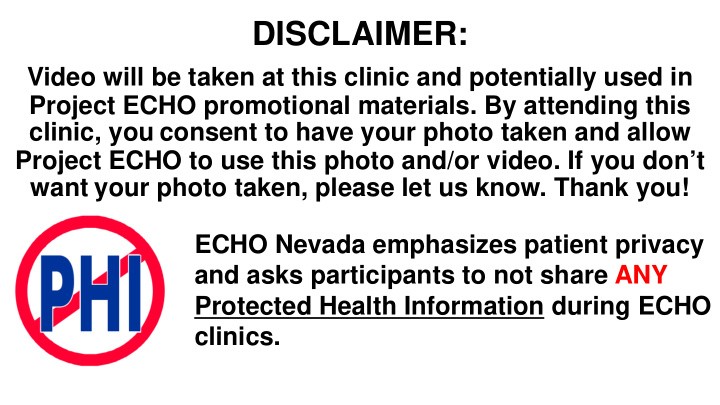



. DISCLAIMER: Video will be taken at this clinic and potentially used in Project ECHO promotional materials. By attending this clinic, you consent to have your photo taken and allow Project ECHO to use this photo and/or video. If you don’t want your photo taken, please let us know. Thank you! ECHO Nevada emphasizes patient privacy and asks participants to not share ANY Protected Health Information during ECHO clinics. .
. The last C.difficile presentation (at least for a few months) JESSICA THOMPSON, PHARMD, BCPS AQ-ID INFECTIOUS DISEASES PHARMACY CLINICAL SPECIALIST RENOWN HEALTH .
. .
. Objectives Discuss the highlights and major differences between the 2010 and 2017 IDSA/SHEA C.difficile guidelines ◦ Slides refer to adult recommendations unless otherwise specificed .
. Diagnosis Preferred population for testing: ◦ Unexplained and new-onset ≥ 3 unformed stools in 24 hour “Clinicians can improve laboratory test relevance by only testing patients likely to have C.difficile disease” Suggestions: • Do not routinely test stool from a patient who has received a laxative in the preceding 48 hours • Develop, implement, and enforce stool rejection criteria .
. Testing In summary: Most facilities If you are unable optimize testing and/or rejection criteria do not use PCR alone for diagnosis .
. Repeat testing Test of cure: ◦ 60% of patients may remain positive Test for recurrence (i.e. recurrence of symptoms following successful treatment and diarrhea cessation): ◦ Use toxin detection, not NAAT (eg. PCR) .
. Implement antimicrobial stewardship Minimize Minimize the Restrict frequency and number of fluoroquinolones, duration of high- antibiotic agents clindamycins, and risk antibiotics prescribed cephalosporins .
. Treatment Discontinue therapy with the inciting antibiotic agent(s) as soon as possible, as this may influence the risk of recurrence Clinical Definition Recommended Treatment Initial episode, non-severe to severe Vancomycin 125 mg PO q6h x 10 days • OR May extend duration Fidaxomicin 200 mg PO BID x 10 days • to 14 days if there is Initial episode, fulminant Vancomycin 500 mg PO/NG q6h delayed treatment • (hypotension, shock, ileus, megacolon) PLUS response Metronidazole 500 mg IV q8h • especially if ileus is present If ileus also add Vancomycin 500 mg retention enema • q6h .
. Surgery No defined criteria for surgical consultation or intervention Type of surgical intervention ◦ Subtotal colectomy with preservation of rectum OR ◦ Diverting loop ileostomy with colonic lavage followed by antegrade vancomycin flushes .
. Treatment of recurrence Clinical Definition Recommended Treatment First recurrence After initial treatment course of metronidazole Vancomycin 125 mg PO q6h x 10 days • • After initial treatment course of vancomycin Vancomycin prolonged tapered and pulsed • • regimen OR Fidaxomicin 200 mg PO BID x 10 days • Second or subsequent recurrence Any one of the following: Vancomycin in a tapered and pulsed regimen • Vancomycin followed by rifaximin chaser • Fidaxomicin x 10 days • Third CDI episode: Fecal microbiota transplant • .
. Metronidazole Should only be used in the following scenarios ◦ Resource-limited settings in non-severe infections ◦ As IV for combination therapy in fulminant C.difficile Irreversible neurotoxicity associated with repeated or prolonged use ◦ Not recommended for treatment of recurrence in adults .
. Pediatric considerations Testing ◦ ≤ 2 years: Do not routinely test > 2 years: Test if prolonged or worsening diarrhea AND risk factors or relevant exposures Treatment .
. Summary Test the right patient Implement stool rejection criteria Don’t use PCR alone *if unable to implement above measures Antimicrobial stewardship No oral metronidazole *except in pediatric patients Pulse/taper vancomycin for 2 nd occurrence FMT for 3 rd occurrence .
. Questions? .
Recommend
More recommend